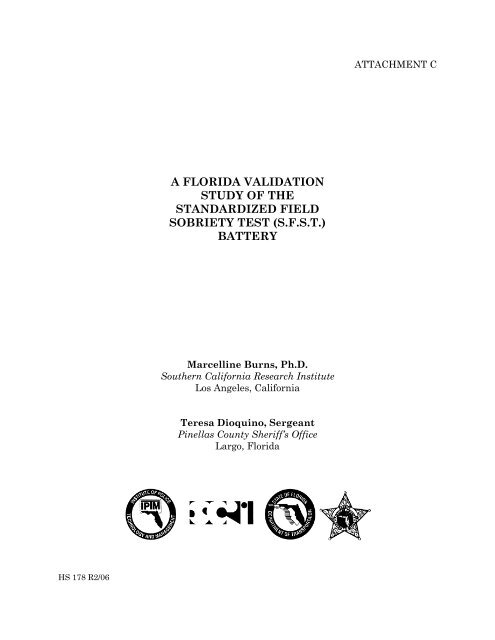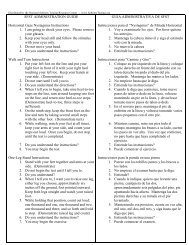STUDY OF THE STANDARDIZED FIELD SOBRIETY TEST (S.F.S.T.) BATTERY
X:\Lesson Plans\SFST\Basic Instrutor\ATTACH8C.wpd
X:\Lesson Plans\SFST\Basic Instrutor\ATTACH8C.wpd
Create successful ePaper yourself
Turn your PDF publications into a flip-book with our unique Google optimized e-Paper software.
ATTACHMENT CA FLORIDA VALIDATION<strong>STUDY</strong> <strong>OF</strong> <strong>THE</strong><strong>STANDARDIZED</strong> <strong>FIELD</strong><strong>SOBRIETY</strong> <strong>TEST</strong> (S.F.S.T.)<strong>BATTERY</strong>Marcelline Burns, Ph.D.Southern California Research InstituteLos Angeles, CaliforniaTeresa Dioquino, SergeantPinellas County Sheriff’s OfficeLargo, FloridaHS 178 R2/06
I. INTRODUCTIONDuring the years 1975-1981, a battery of field sobriety tests was developed underfunding by the National Highway Traffic Safety Administration (NHTSA), U.S.Department of Transportation (Burns and Moskowitz, 1977; Tharp, Burns, andMoskowitz, 1981). The tests include Walk-and-Turn (WAT), One-Leg Stand (OLS),and Horizontal Gaze Nystagmus (HGN). NHTSA subsequently developed atraining curriculum for the three-test battery, and initiated training programsnationwide. Traffic officers in all 50 states now have been trained to administer theStandardized Field Sobriety Tests (SFSTs) to individuals suspected of impaireddriving and to score their performance of the tests.At the time the SFSTs were developed, the statutory blood alcohol concentration(BAC) for driving was 0.10% throughout the United States. The limit now has beenlowered in a number of states to 0.08% for the general driving population. “Zerotolerance” is in effect in some jurisdictions for drivers under age 21, and commercialdrivers risk losing their licenses at a BAC of 0.04%. It is likely that additionalstates will enact stricter statutory limits for driving. In light of these changes, a reexaminationof the battery was undertaken by McKnight et al. (1995). Theyreported that the test battery is valid for detection of low BACs and that no othermeasures or observations offer greater validity for BACs of 0.08% and higher.The three tests have been incorporated into Drug Influence Evaluations (DIEs)which are conducted by certified Drug Recognition Experts (DREs) whenever anindividual is suspected of being drug-impaired. As part of a DRE evaluation, theSFSTs provide important evidence of drug impairment and contribute to the DRE’sthree-part opinion:# Is the individual impaired by a drug or drugs?# If yes, is the impairment drug-related?# If yes, what category or categories of drug account for the impairment?A study was conducted in Colorado to examine the validity of the SFSTs when usedby experienced officers in the field (Burns and Anderson, 1995). The design of thestudy insured that roadside testing was limited to the three-test battery, and thatofficers’ decisions were not influenced either by the driver’s performance of otherbehavioral tests or by measurement of BAC with a preliminary breath tester (PBT).The obtained data demonstrated that more than 90% of the officers’ decisions toarrest drivers were confirmed by analysis of breath and blood specimens.A recently-reported NHTSA-funded study was conducted by Anacapa Sciences, Inc.in collaboration with the San Diego Police Department to examine the validity ofthe SFSTs for both 0.08% and 0.04% (Stuster and Burns, 1997). Officers’ estimatesof whether a driver’s BAC was above or below 0.08% or 0.04% were found to bemore than 90% correct.HS 178 R2/06 2
The Colorado and California studies provide relevant and current field data. Thevalidity of the tests when they are administered in the context of drug evaluationswas examined in a retrospective analysis of the records of the Phoenix DRE Unit(Adler and Burns, 1994). It was found that a suspect’s performance of the testsprovides valid clues of drug impairment.The study reported here was conducted in collaboration with the Pinellas CountySheriff’s Office (PCSO) and expands the examination of the SFSTs to the State ofFlorida. An overview of PCSO and the demographics for Pinellas County can befound in Appendix I.II.<strong>STUDY</strong> BACKGROUND AND RATIONALEDuring the early years of SFST use by law enforcement, legal challenges wererelatively infrequent. For more than a decade now, however, defense counsel inmany jurisdictions has sought to prevent the admission of testimony about adefendant’s performance of the three tests. The objections, which continue to bepersistent and vigorous in 1997, typically focus on test validity and reliability asdemonstrated in the original laboratory research. It is entirely appropriate toinquire whether that early research to identify a best set of sobriety tests wasconducted with scientific rigor. Beyond that inquiry, however, the data, which wereobtained in a laboratory setting and now are more than twenty years old, are oflittle interest. Certainly, they are only marginally relevant to current roadside useof the tests. The questions which begs to be addressed in 1997 is whether the testsare valid and reliable indices of the presence of alcohol when they are used atroadside under present day traffic and law enforcement conditions.Experience and confidence have a direct bearing on an officer’s skill with roadsidetests. In this regard, note that the officers who participated in the early SCRIstudies had been only recently and briefly (4 hrs) trained to administer the testbattery. There had been no time for them to use the tests in the field where theymight have developed confidence in decisions based on them. Nonetheless, theirdecisions were 76% correct in the first study and 81% correct in the second study.At this point in time, many traffic officers have had ten or more years’ experiencewith the test battery and many report that they confidently rely on them. Since itseems unlikely in the extreme that they would continue to rely on tests whichrepeatedly lead to decision errors, it is a reasonable assumption that more oftenthan not their roadside decisions to arrest are supported by measured BACs.Whether their decisions to release are correct is largely unknown since the releaseddriver’s BAC generally is not measured.HS 178 R2/06 3
Traffic officers are charged with the detection and arrest of impaired drivers.Although their roadside duties are central to roadway safety, recognition of alcoholimpaireddrivers can be difficult and is, therefore, subject to error. If officers are toeffectively meet this particular enforcement responsibility, they need to augmenttheir general observations of suspects with sensitive, accurate sobriety tests. Thetests not only aid in the removal of dangerously impaired drivers from the roadway,they also protect the driver who is not alcohol or drug impaired from beingimproperly detained. Thus, rigorous examinations of the SFSTs are important totraffic safety.V. RESULTSThe first record in the data base is for an arrest which occurred on June 1, 1997,and the last record is dated September 4, 1997. During the study period, 379records were submitted for the study. Figure 3 graphs the total number of recordsby month. As expected, the initial activities generated enthusiasm amongparticipants, and the largest number of citizen contacts occurred during the firstproject month. Although available time of participating officers was affected duringJuly and August by scheduled training days and vacations, and although it typicallyis difficult to sustain the initial high interest level, the actual decline in arrests overthe extended project period was not large. The final month is not comparable, sincedata collection extended only a few days into September.HS 178 R2/06 4
A. Total Sample and Measured BACsTable 3 summarizes the disposition of 379 records obtained during this study. Ascan be seen in the table and in Figure 4, the BACs of 256 drivers were measured.Thus, BACs are available for 81.8% of the 313 cases entered into an analysis ofofficers’ decisions. Evidential testing at the booking facility accounts for 210 of theBACs. Forty-six were obtained with a Preliminary Breath Testing (PBT) device. Alog of all cases appears in Appendix IV.VI.SUMMARY AND DISCUSSIONLegislators have lowered the limits for alcohol levels in drivers from 0.15%, whichwas the very early standard, to 0.10% or 0.08%. The lower statutory limits aresoundly based in data from scientific experiments and form epidemiology and arean important step toward safer roadways. Whether their full potential for reducingalcohol-involved crashes can be reached, however, depends on effective enforcement.Failure to enforce a statute, whatever the reason for the failure, weakens thatstatute and may actually render it counterproductive to some degree.Traffic officers are the first link in the series of events that brings a DUI driver intothe criminal justice system. Unless officers are able to detect and arrest impaireddrivers, those drivers will not experience the sanctions which are intended to deterimpaired driving. Although there are many aspects to effective DUI enforcement,certainly it is crucial for officers to be proficient in assessing the alcohol impairmentof drivers they detain at roadside.As an aid to their roadside decisions, officers rely upon a battery of tests, theSFSTs, to augment their general observations of a driver. At this point in time, noother tests have been shown to better discriminate between impaired andunimpaired drivers. Nonetheless, the battery, and in particular Horizontal GazeNystagmus, frequently is attached vigorously during court proceedings. Thus, theexamination of officers’ decisions, based on the SFSTs, is of considerable interest.If it can be shown that officers’ reliance on the tests is misplaced, causing themfrequently to err, then the officers, the courts, and the driving public need to beaware that the tests are not valid and that DUI laws are not bing properly enforced.If, on the other hand, it can be shown that officer typically make correct decisions,based on the SFSTs, perhaps the legal controversy that has centered on them formore than a decade can be diffused and court time can be devoted to moresubstantive issues.HS 178 R2/06 5
The data obtained during this study demonstrate that 95% of the officers’ decisionsto arrest drivers were correct decisions. Furthermore, 82% of their decisions torelease drivers were correct. It is concluded that the SFSTs not only aid policeofficers in meeting their responsibility to remove alcohol-impaired drivers from theroadway, they also protect the rights of the unimpaired driver. These data validatethe SFSTs as used in the State of Florida by Pinellas County Sheriff’s deputies whohave been trained under NHTSA guidelines. SFST validity now has beendemonstrated in Florida, California (1997) and Colorado (1995). There appears tobe little basis for continuing legal challenge.ReferencesBurns, M. (1990) Development and Pilot Test of a Computer Data Base of DrugEvaluations of Impaired Drivers. No. 90M079578301D.Burns, M. and Adler, E.V. (1994) Drug Recognition Expert (DRE) Validation Study.Final Report, E0072023, Governor’s Office of Highway Safety, State ofArizonaBurns, M. and Anderson, E. (1995) A Colorado Validation Study of theStandardized Field Sobriety Test (SFST) Battery. Final Report, ColoradoDepartment of Transportation.Burns, M. and Moskowitz, H. (1977) Psychophysical Tests for DWI Arrest. FinalReport, DOT-HS-802 424, NHTSA, U.S. Department of Transportation.McKnight, A.J., Langston, E.A., Lange, J.E., and McKnight, A.S. (1995)Development of Standardized Field Sobriety Test for Lower BAC Limits(SFST-LL), Final Report, DTNH22-92-07000, NHTSA, U.S. Dept. ofTransportation.Stuster, J. and Burns, M. (1977) Validation of the Standardized Field Sobriety TestBattery at BACs Below 0.10 Percent. Final Report, DTNH22-95-C-05192,NHTSA, U.S. Dept. of Transportation.Tharp, V., Burns, M. and Moskowitz, H. (1981). Development and Field Test ofPsychophysical Tests for DWI Arrests. Final Report, DOT-HS-805-864,NHTSA, U.S. Dept. of Transportation.HS 178 R2/06 6




